Ghormeh Sabzi is an aromatic meat stew stuffed with flavorful green herbs. It is so popular in Iran it even has its own unofficial holiday.
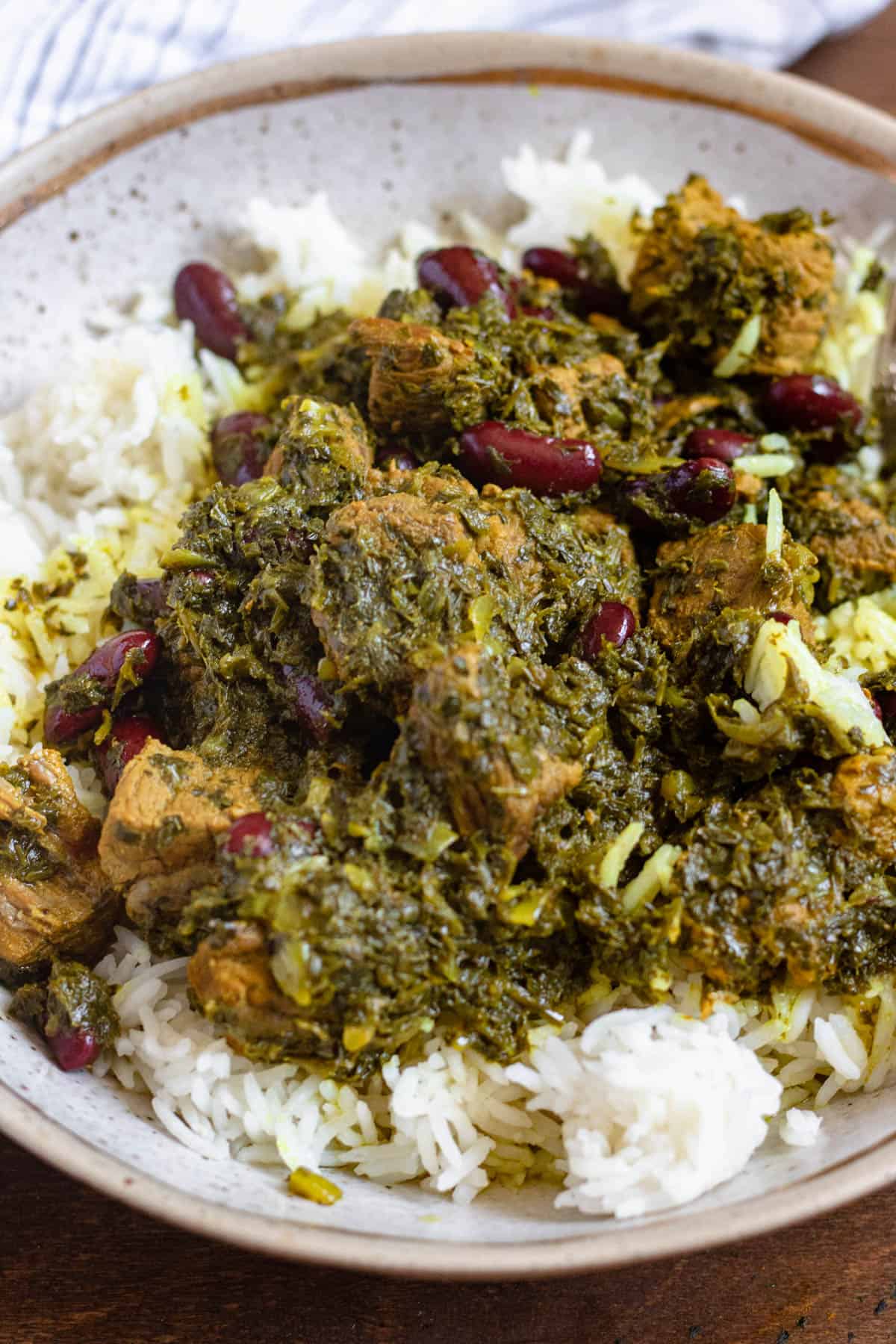
Hello Reader! I try my hardest to research recipes as best as I can before posting to ensure I am representing each culture correctly. If this recipe is from your country and I have made a mistake or you have suggestions for how to make it more authentic, I would love to hear! Please leave a comment below letting me know what should be different, and I will rework the recipe. It is always my intention to pay homage and respect to each cultural dish that I cook. Thanks for reading!
Iranian cuisine is known for elaborate rice dishes and flavorful stews, called khoresh, and Ghormeh Sabzi is one of the most popular.
The base of this delicious stew is a pile of fresh herbs cooked down to concentrate the flavor. It’s combined with minced or seared beef or lamb that has been seasoned with tumeric. The Omani limes, or dried Persian limes, add a distinct tanginess that bring out all the flavors.
Red beans make this a satisfying and filling dish, especially when served over white rice. Don’t be thrown off by how much time this stew needs to cook. The many minutes of cooking are worth the wait!
Recipe Origins
Stews and rice are the staples of Iranian cuisine but Ghormeh Sabzi stew is one of the most popular. “Ghormeh” means braised and refers to the meat in the stew while “sabzi” is the Persian word for herbs.
It is said that the origin of this stew dates back thousands of years when tribes would cook meat in salt. They would then wrap it in animal skin to easily carry it with them as they traveled. Later when they ate the meat, it would be combined with herbs and lemon powder.
Over time the recipe has been perfected to become one of the most beloved Persian stews. It is sometimes called the national dish of Iran because it was created there and the flavors are so distinct. It has become so popular that there is even an unofficial International Ghormeh Sabzi Day on the last Saturday of November, two days after Thanksgiving.
Why Make this Recipe
- Easy Stovetop Preparation: With a long list of herbs, many think this recipe will be complex but it’s actually fairly simple. Once prepared it can simmer slowly on the stovetop.
- Unique flavor combination: The addition of lime to this stew may surprise you, but mixed with the herbs and salty meat, it’s a perfect pairing that is very unique to this cuisine.
- One-pot dish. You can prepare all your ingredients for this dish in one pot making for easy cleanup!
What Do I Need to Make this Recipe?
Ingredients
Here is a visual overview of the ingredients in the recipe. Scroll down to the recipe at the bottom for quantities.
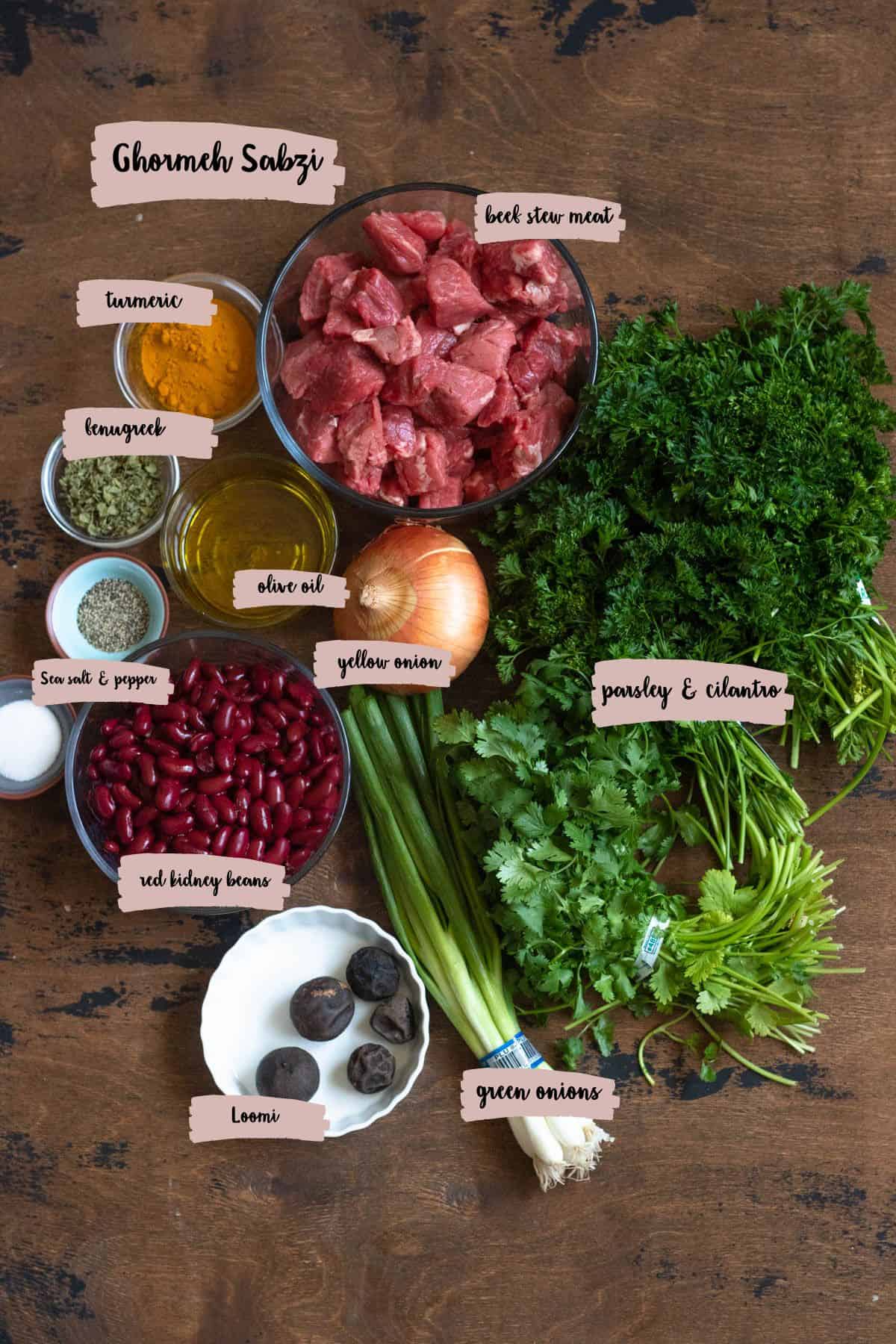
- Herbs: The mixture of sauteed herbs are the main ingredient of this stew and of Iranian cuisine in general. The cooked herbs provide not only a strong kick of flavor but they are packed with nutrients too. Allowing the herbs to saute slowly is a very important step. You do not want to burn them but you also don’t want them undercooked.
- Meat: What would a stew be without hearty meat? You can use beef stew meat or lamb chunks. I used beef stew meat in this recipe.
- Dried Limes: This stew features the tanginess of Limu Omani, also known as dried Persian limes, black lime, or loomi. It would not be the same without this flavor addition. Limu Omani is a seedless lime that has been soaked in brine and then dried out. The color of the limes may vary but they are usually black or brown. Poke a small hole in the lime before tossing it into the stew to allow more flavor, sourness, and a little acidity to be released as it cooks. You can usually find dried limes in a bag near other dried spices in a Middle Eastern store. It can even be purchased online. If you’re really in a pinch you could use fresh lime juice or fresh lemon juice but the full flavor is not the same.
- Fenugreek: You can use fresh or dried fenugreek. If using fresh, grind it up with the rest of the herbs. Fresh fenugreek can be hard to find in the United States, so you can also purchase it dried (bought online here).
- Red Kidney Beans: I am using canned kidney beans for ease of preparation, but most recipes call for using dried red kidney beans. In this case, soak the kidney beans overnight and cook them in the stew alongside the meat.
Tools
- Pot: Choose a big pot that is large enough to hold a mountain of herbs and meat and has a secure lid for simmering.
- Food Processor: You could chop all your ingredients by hand but it’s much easier to throw all the herbs into a food processor to chop them down.
- Stovetop: Allow this stew to slowly simmer for a long time on your stovetop for the best results. A slow cooker might retain too much moisture and create a watery soup, while an instant pot may not allow for the depth of flavor that slow cooking provides.
How to Make this Recipe
Step 1: Prepare the Herbs

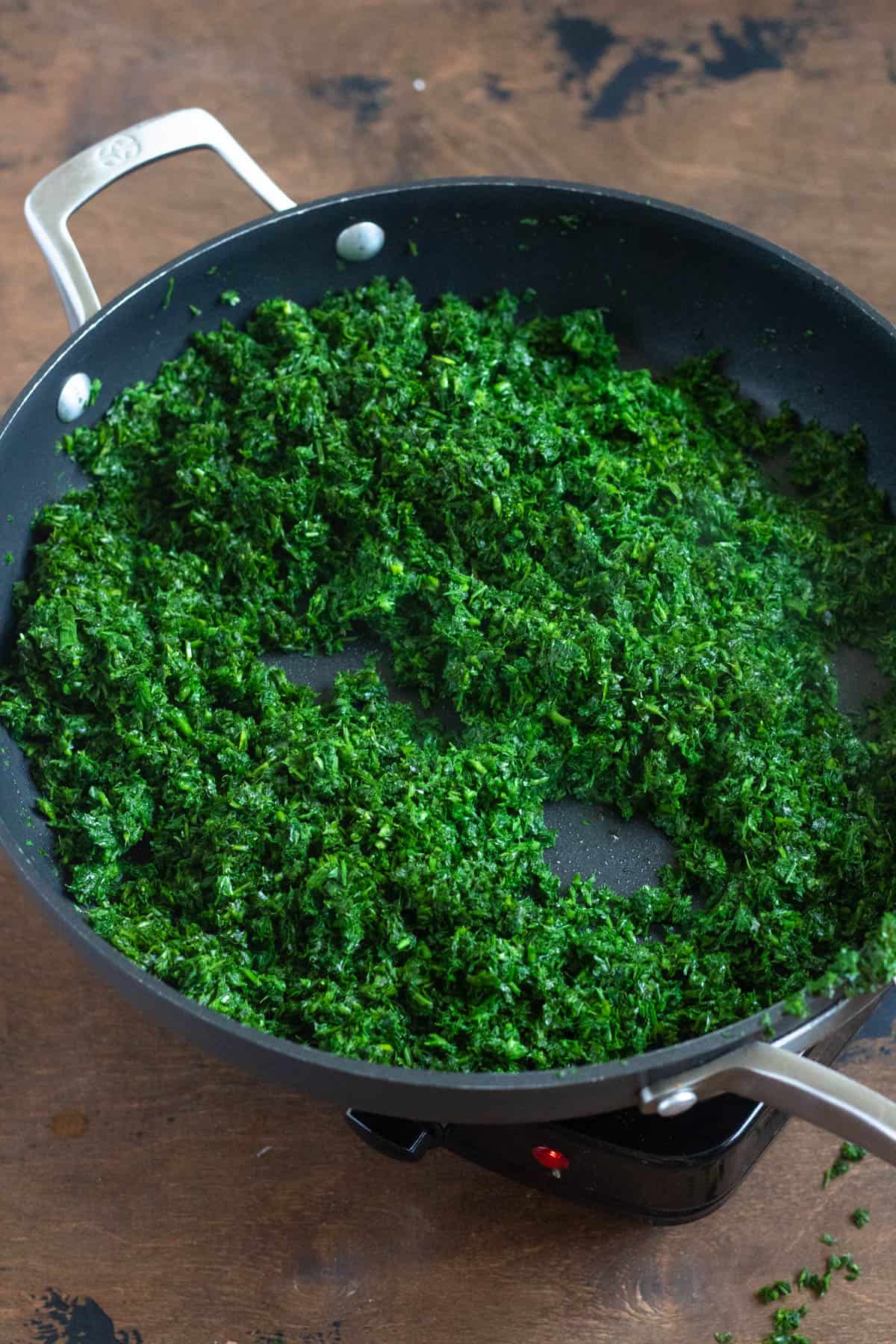
Chop your herbs (or use a food processor) until they are in very fine pieces. You may have to go in batches if your food processor is very small.
Add ¼ cup olive oil to a large frying pan (or the bottom of a large pot) and then add the herbs to the pan along with the fenugreek leaves.
Fry for about 5-8 minutes over medium heat until the herbs turn darker. Remove the herbs from the pan.
Step 2: Sautee Your Meat
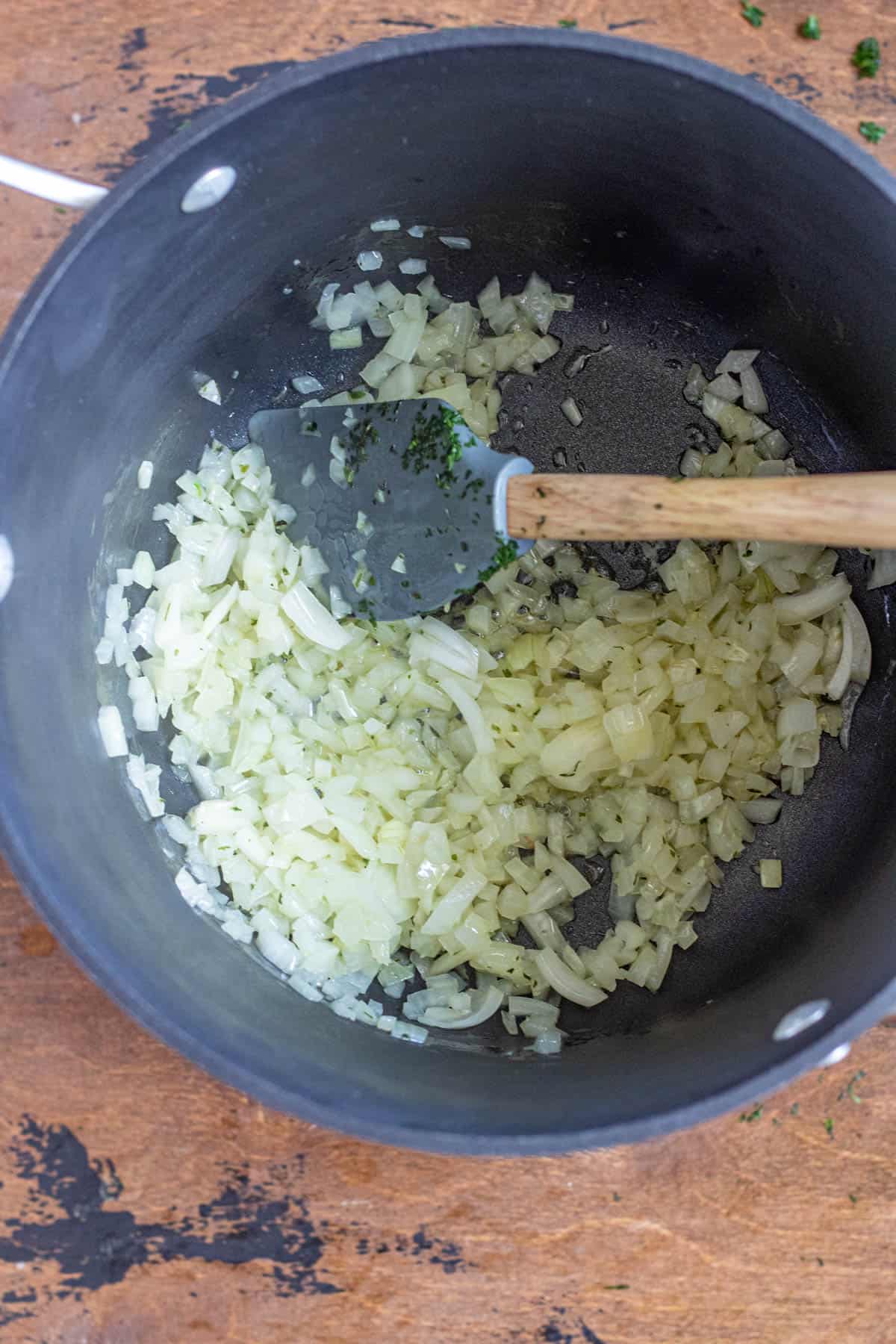
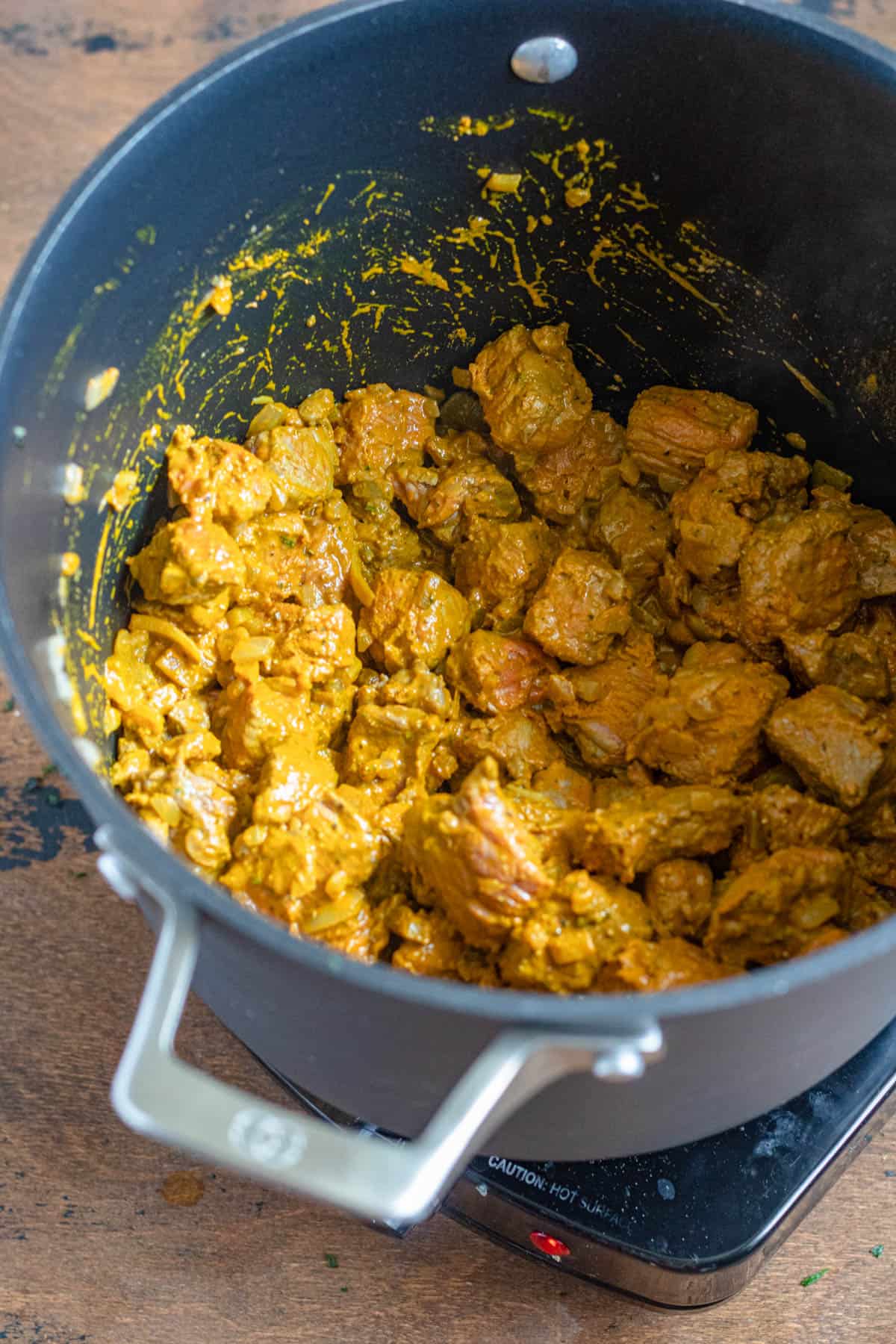
In a large pot add ¼ cup olive oil and then the chopped onions.
Cook on medium-high heat until your onions begin to brown.
Add the beef into the pot and stir until the outside of the meat is browned. While it’s browning, add the black pepper, turmeric, and salt. Mix to combine.
Step 3: Combine your Ingredients
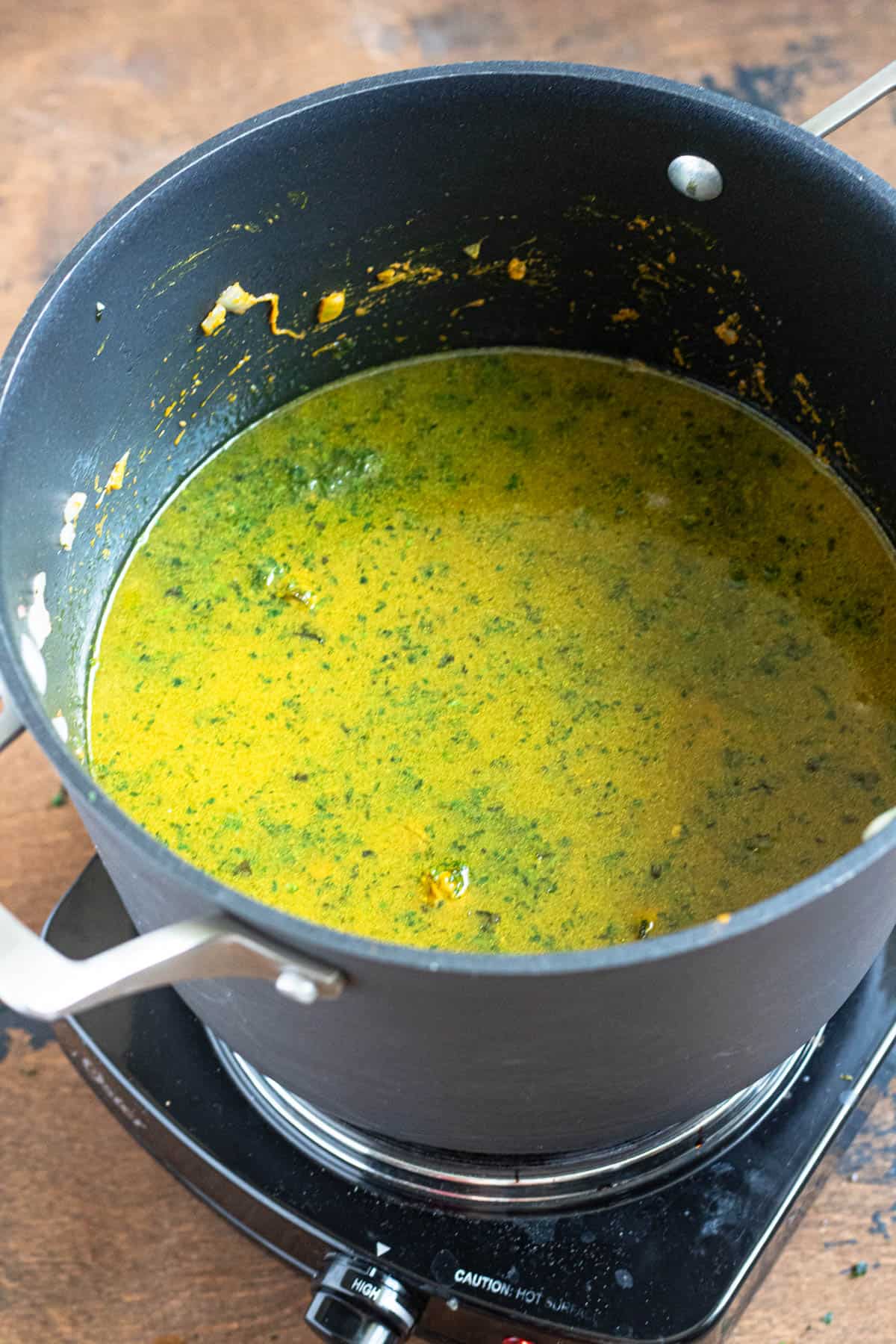
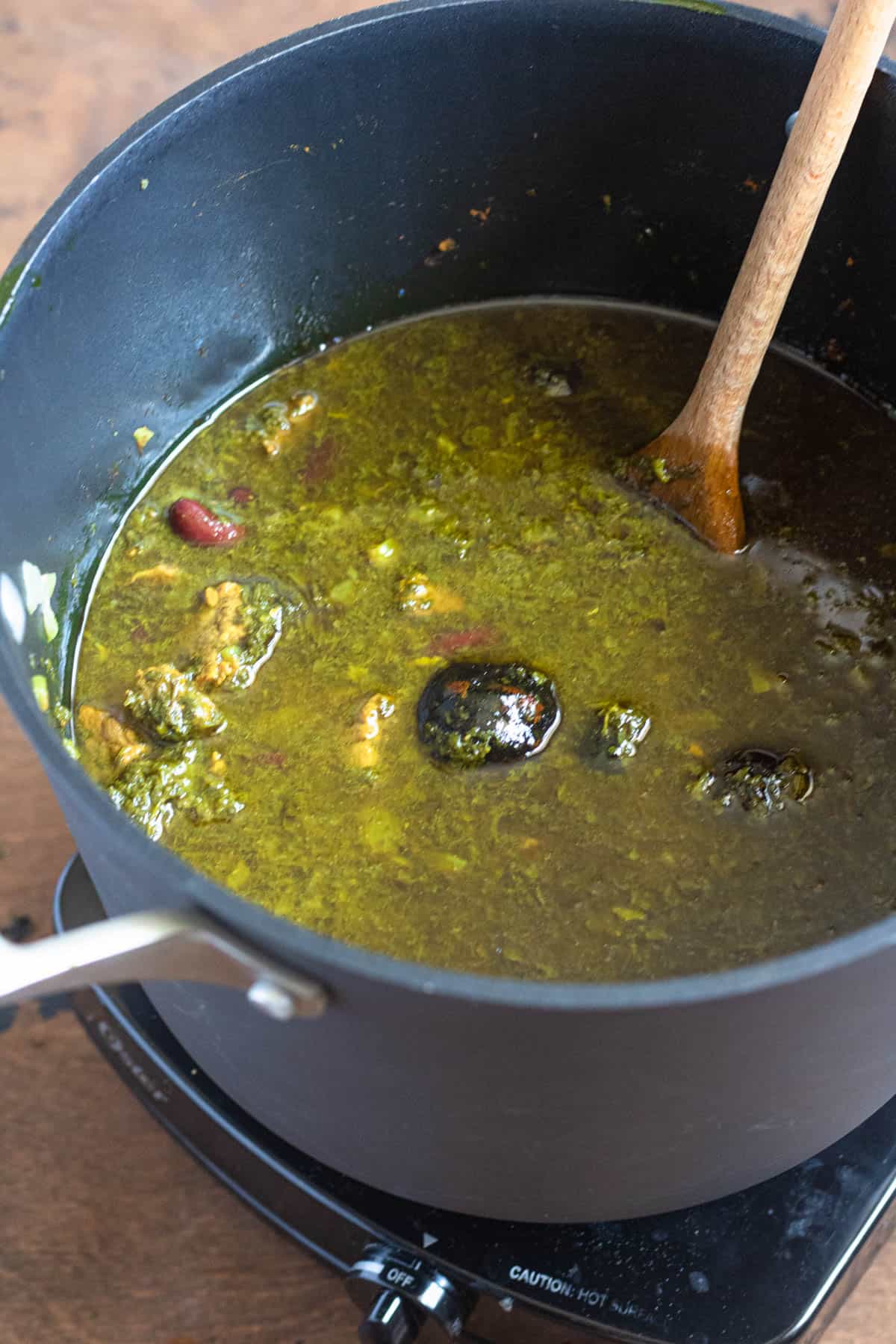
Add the sauteed herbs back into the pot with your meat mixture. Mix to combine, then add 4-6 cups of hot water into the pot. Bring it to a boil.
Add the dried limes into the pot and allow the stew to boil for 5 minutes on a medium high heat.
Reduce the heat to medium-low and let it simmer on low heat for 1.5 hours at a minimum, but up to 3 hours.
After the stew is done cooking, add the red kidney beans to the stew and mix it in. When finished the stew should be a dark shade of green. Serve with saffron rice and enjoy!
How to Make Ghormeh Sabzi Using Dried Herbs
I highly recommend using fresh herbs for your Ghormeh Sabzi if you can, but some people do need to use dried herbs instead! If you need to use dried herbs, only use about ¼ of the quantity that this recipe calls for.
Place the herbs in a colander and then soak them in a bowl of water for 20 minutes to rehydrate them.
Use a paper towel or clean dish towel to squeeze the water out of the herbs. Then proceed as usual!
Expert Tips
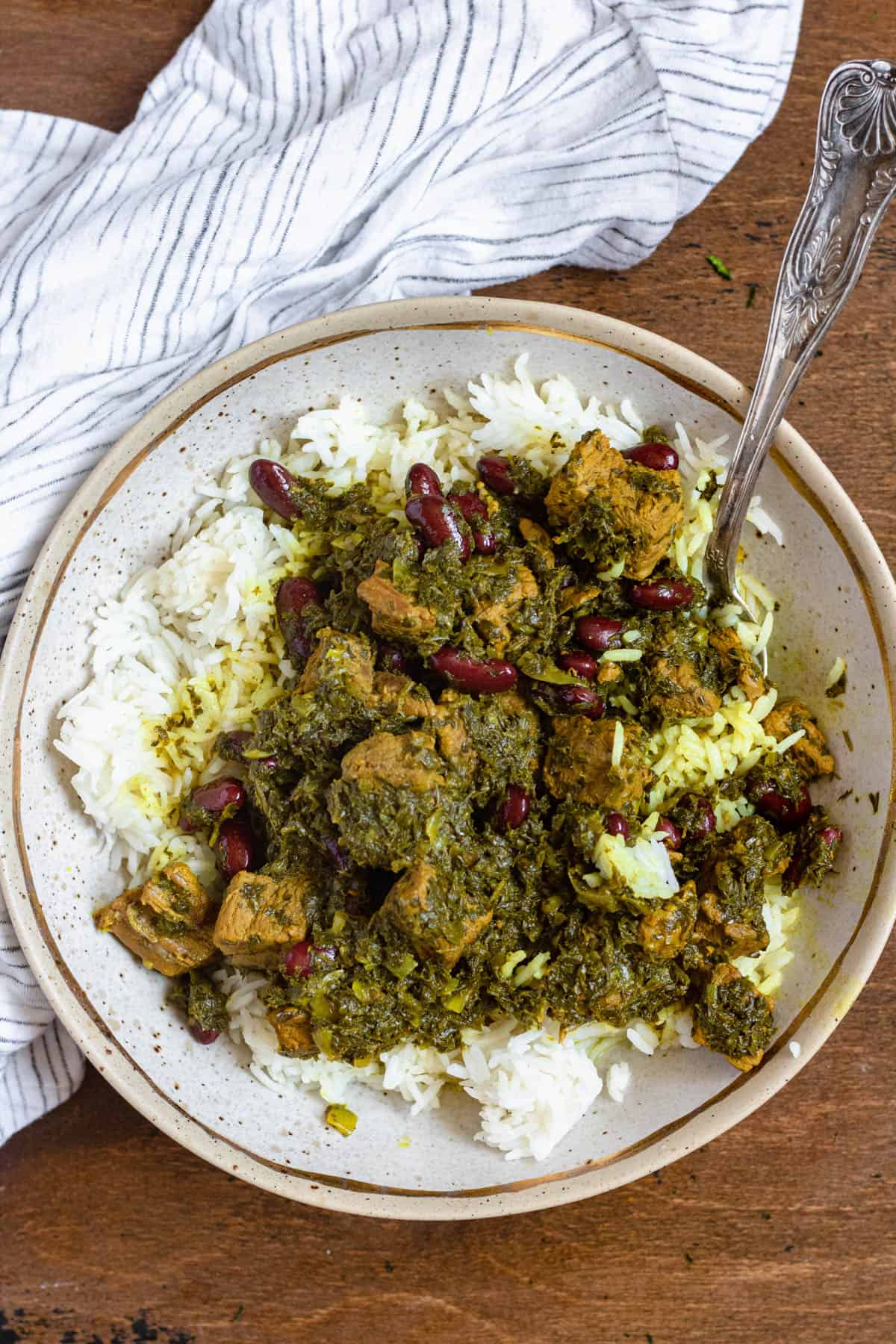
- Don’t try to rush through preparing this stew. As the herbs are cooked down in the beginning their flavor is concentrated. If you try to use the herbs without cooking them down your stew may end up watery.
- The longer the stew simmers, the more the flavors combine. When ready, the meat should be perfectly tender.
- If your stew looks watery, let it simmer uncovered for the last 30 minutes or so of cooking. It should be a thick stew with a deep, dark green color.
- Too much fenugreek can turn your stew bitter, so make sure to follow the recommended ingredient portion.
- Pre-rinse your red meat to remove the blood for best results
- Depending on what part of Iran this dish is made in, you can also choose to replace the Red Kidney Beans with pinto beans or black eyed peas
Recipe FAQs
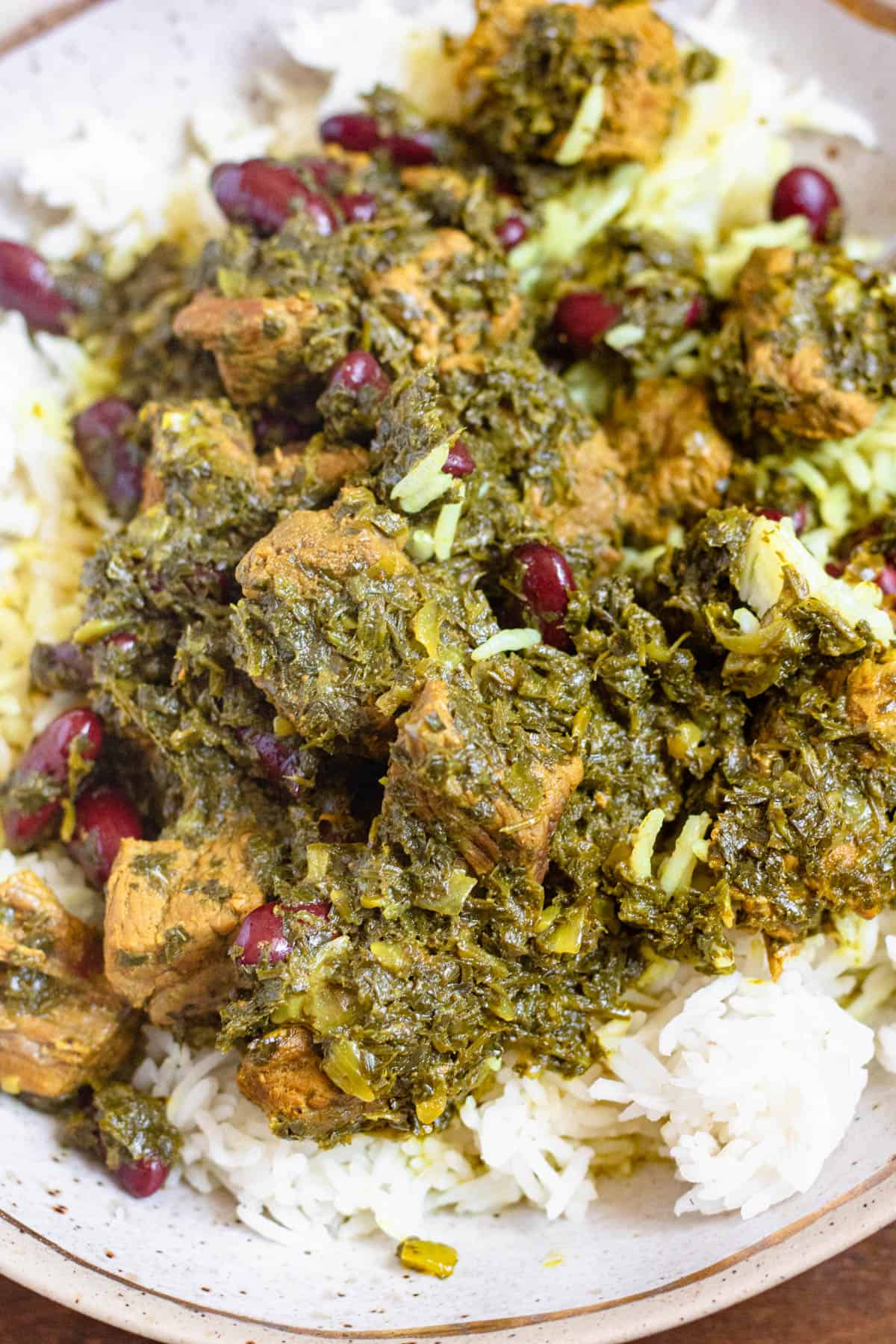
This stew is traditionally served over Basmati rice or Baghali Polo.
This recipe makes for amazing leftovers. Store in the refrigerator for up to one week. If you are freezing your Ghormeh Sabzi, it can be frozen for up to 3 months.
Yes! If you’d like to make this recipe vegetarian or vegan, you can make this dish with chopped up brown mushrooms! Keep the rest of the recipe the same.
Did you enjoy this Ghormeh Sabzi recipe? If so, make sure to check out these other recipes I picked out just for you:

Persian Ghormeh Sabzi
Equipment
- Pot(s)
- Food Processor
- Stovetop
- Frying Pan
Ingredients
- 4 bunches parsley
- 2 bunches chives, whites removed
- 2 bunches cilantro
- ½ cup olive oil, divided
- 1-2 tbsp dried fenugreek
- 1 yellow onion, chopped
- 2 lb beef stew meat, rinsed to remove all of the blood
- 1 tsp black pepper (Use code FF20 for 20% off)
- 2 tbsp turmeric
- 2 tsp sea salt
- 5 dried limes, with holes poked in them
- 2 15 oz red kidney beans, drained and rinsed
Instructions
- Chop your bunches of fresh parsley, chives and cilantro herbs (or use a food processor) until they are in very fine pieces. You may have to go in batches if your food processor is very small.
- Add ¼ cup olive oil to a large frying pan and then add the herbs to the pan along with the 1-2 tbsp fenugreek. Fry for about 5-8 minutes on a medium temperature until the herbs turn darker. Remove the herbs from the pan.
- In a large pot add ¼ cup olive oil and then the chopped yellow onion. Cook until your onions begin to brown.
- Add two pounds beef into the pot and stir until the outside of the meat is browned. While it’s browning, add the 1 tsp black pepper, 2 tbsp turmeric, and 2 tsp salt. Mix to combine.
- Then add the herbs into the pot. Mix to combine, then add 4-6 cups of water into the pot. Bring it to a boil.
- Add the 5 dried limes into the pot and allow the stew to boil for 5 minutes.
- Reduce the heat to medium-low and let it simmer for 1.5 hours at a minimum, but up to 3 hours.
- Add the 30 oz red kidney beans to the stew and mix it in.
- Serve with basmati rice with saffron and enjoy!
Notes
- Researched using Cooking with Yousef and At Home with Tara.
- Herbs: The mixture of sauteed herbs are the main ingredient of this stew and of Iranian cuisine in general. The cooked herbs provide not only a strong kick of flavor but they are packed with nutrients too. Allowing the herbs to saute slowly is a very important step. You do not want to burn them but you also don’t want them undercooked.
- Meat: What would a stew be without hearty meat? You can use beef stew meat or lamb chunks. I used beef stew meat in this recipe.
- Dried Limes: This stew features the tanginess of Limu Omani, also known as dried Persian limes, black lime, or loomi. It would not be the same without this flavor addition. Limu Omani is a seedless lime that has been soaked in brine and then dried out. The color of the limes may vary but they are usually black or brown. Poke a small hole in the lime before tossing it into the stew to allow more flavor, sourness, and a little acidity to be released as it cooks. You can usually find dried limes in a bag near other dried spices in a Middle Eastern store. It can even be purchased online. If you’re really in a pinch you could use fresh lime juice or fresh lemon juice but the full flavor is not the same.
- Fenugreek: You can use fresh or dried fenugreek. If using fresh, grind it up with the rest of the herbs. Fresh fenugreek can be hard to find in the United States, so you can also purchase it dried (bought online here).
- Red Kidney Beans: I am using canned kidney beans for ease of preparation, but most recipes call for using dried red kidney beans. In this case, soak the kidney beans overnight and cook them in the stew alongside the meat.
- Don’t try to rush through preparing this stew. As the herbs are cooked down in the beginning their flavor is concentrated. If you try to use the herbs without cooking them down your stew may end up watery.
- The longer the stew simmers, the more the flavors combine. When ready, the meat should be perfectly tender.
- If your stew looks watery, let it simmer uncovered for the last 30 minutes or so of cooking. It should be a thick stew with a deep, dark green color.
- Too much fenugreek can turn your stew bitter, so make sure to follow the recommended ingredient portion.
- Pre-rinse your red meat to remove the blood for best results
- Depending on what part of Iran this dish is made in, you can also choose to replace the Red Kidney Beans with pinto beans or black eyed peas



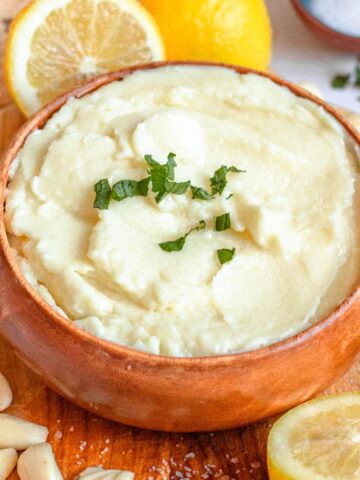
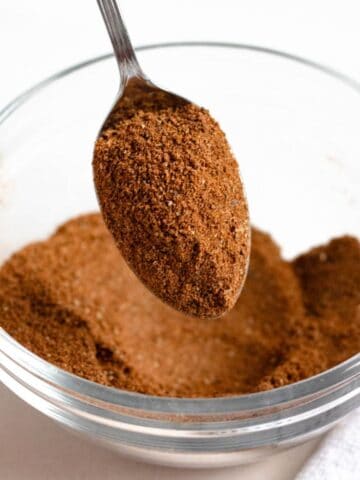
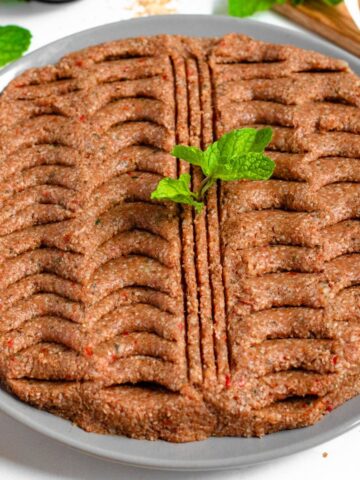
Nina says
The recipe was perfect. I have a recommendation. I cook this dish all the time but to save time I cook everything in the insta pot for the time the meat is fully cooked then I transfer it in a pot to let it simmer for 15 minutes on the stove top this way is much faster.
The Foreign Fork says
Thats a great idea Nina! Thank you for the recommendation and the rating! 🙂
Shayan says
DO NOT mix your ghorme sabzi with rice as in picture. Do it gradually, half a spoon rice then half a spoon ghorme sabzi. I’ve seen many foreigner completely emptying their ghorme sabzi bowl on the rice and start mixing them. THAT’S WRONG.
Azadeh says
As an iranian The best ghorme Sabri I have tested almost every week doesn’t need so much pieces of meet. If you can use a good balance of the fresh herbs and, let it to cook wel you will have one of the best tastes in the world.